How do dentists treat gum disease?
Treatment of periodontal disease begins with the removal of plaque and tartar. A common first step is scaling and root planning which seeks to remove tartar by scraping it from the surface of each tooth. The problem with tartar or dental calculus as it’s more formally known, is that it contains harmful bacteria. The recommended method of removing tartar is a dentist administered teeth cleaning, or what Archer Dental calls hygiene therapy.
The photos at the side of the page expand when clicked and show the many signs and symptoms of gum disease. This page covers the following topics of interest related to the treatment of periodontal disease:
- What is periodontal disease?
- What are signs of gum disease?
- What are the signs of Gingivitis?
- What are the signs of Periodontitis?
- How long does it take for gum disease to develop?
- Can you get rid of periodontal disease?
- How to reverse periodontal disease?
- Is gum disease contagious?
- Does periodontal disease kill people?
- How to stop Gum Disease?
Gingivitis is the most common form of periodontal disease (non-destructive). It is when there’s an inflammation of the gum tissue. When plaque builds up on the surface, it’s called plaque-induced gingivitis. If left untreated, it can escalate to the destructive form, Periodontitis, which affects the tissues that support and surround the teeth. With poor oral care, bacteria can infiltrate the gum line and affect the underlying bone. If left untouched, it can lead to damage of the teeth’s supporting tissues, loosened teeth, and eventually lost teeth.
What is gum disease?
Periodontitis, also called gum disease, is the result of a serious gum infection that damages the soft tissue of the mouth. Without proper treatment in the early stages of the disease, periodontal disease can destroy the bone that supports your teeth. Periodontitis can cause teeth to loosen and lead to tooth loss. Periodontitis accounts for more tooth loss among adult Canadians than cavities or accidents.
Periodontitis is very common, especially with seniors, but it is largely preventable.
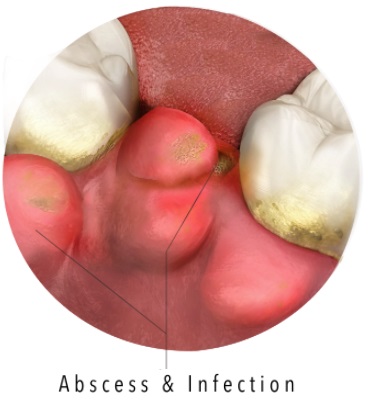
What are signs of gum disease?
Knowing the symptoms of periodontal disease can inform patients about their own condition and the amount of forward progress the bacteria is making in their mouths. Healthy gums are firm and pale pink and fit snugly around teeth. Signs of periodontitis can include:
- Swollen or puffy gums, painful chewing
- Bright red, dusky red or purplish gums
- Gums that feel tender when touched
- Gums that bleed easily
- Pink-tinged toothbrush after brushing
- Spitting out blood when brushing or flossing your teeth
- Bad breath
- Pus between your teeth and gums
- Loose teeth or loss of teeth
- New spaces developing between your teeth
- Gums that pull away from your teeth (recede), making your teeth look longer than normal
- A change in the way your teeth fit together when you bite
People who experience any of these symptoms should contact Archer Dental as soon as possible.
What are the signs of Gingivitis?
Gingivitis is a common and mild form of gum disease, or periodontal disease that causes irritation, redness and swelling of patients’ gingiva, the part of the gum around the base of the teeth.
Some signs a dental patient suffers from gingivitis include,
- Red, swollen, or tender gums
- Occasional bleeding and comfort while brushing or flossing
- Bad breath
It’s important to take gingivitis seriously and treat it promptly. Gingivitis can lead to more serious gum disease called periodontitis and tooth loss. Getting a professional teeth cleaning at Archer Dental is a terrific way to stay ahead of the build-up. Regular brushing and flossing helps maintain cleanliness.
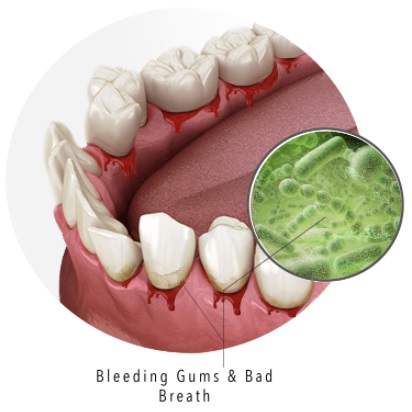
What are the signs of Periodontitis?
Generally speaking, when bacteria in the mouth infects tissue surrounding the tooth, it causes the inflammation that leads to periodontal disease. When bacteria stay on the teeth long enough, plaque eventually hardens to tartar. This calculus build-up can spread below the gum line, which makes the teeth harder to clean. At that point, only a dental health professional can remove the offending tartar and stop the progression of gum disease.
Signs a dental patient suffers from periodontitis, or gum disease, include,
- Painfully red and swollen gums
- Frequent bleeding while brushing or flossing
- Gums that pull away from the teeth
- Persistent bad breath or a constant metallic taste in patient’s mouth
- Loose or separating teeth
- An alteration in the way the patient’s teeth fit together
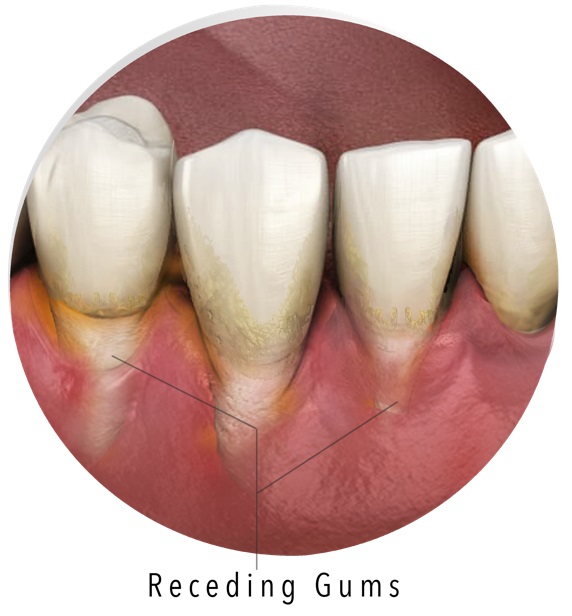
How long does it take for gum disease to develop?
Dentists at Archer Dental have found it convenient to categorize the five stages of gum disease to help patients spot the signs of periodontitis and get treatment in time.
As stated earlier, gum disease is the leading cause of tooth-loss in adult Canadians, spoiling more smiles than cavities and accidents combined. But the earlier the condition is detected, the easier it is to treat.
1. First Signs of Gingivitis
Itchy gums and sore teeth are among the first signs of gum disease in an otherwise healthy mouth. The patient’s gums seem normal, with no swelling or irritation, but they notice occasional bleeding when eating certain foods such as apples. Mild smears of blood are normal from time to time even in healthy gums, it’s when patients notice it frequently they should increase oral hygiene accordingly.
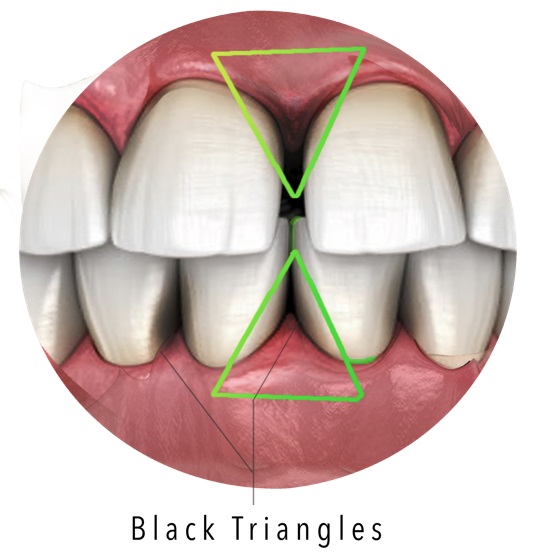
2. Gingivitis
Gingivitis is the name applied to early-stage gum disease, and stage two is where it’s usually first noticed and labelled as a condition by dentists. The plaque on the patient’s teeth has begun to accumulate causing irritation and swelling and a dental hygiene appointment. The patients’ gums bleed and sometimes discharge a milky white material called exudate.
Our hygiene team at Archer Dental will get to work right away to remedy gingivitis by giving the subject’s teeth a thorough cleaning to remove excess plaque. Being diagnosed with gingivitis should help convince the patient to change their habits and step-up their brushing and flossing regime.
3. Early Periodontitis
When gingivitis is left untreated, it progresses to stage one periodontitis, also known as gum disease. Soft tissue around the teeth is inflamed and tender to the touch and may have turned a paler shade of pink as the blood supply is reduced.
The plaque around the patient’s teeth has hardened into a tougher, more damaging material called calculus or tartar, and this substance accelerates the damage. At this stage, the bone structures anchoring the patient’s teeth to his or her jaw are weakened, and they’re at much greater risk of tooth loss.
4. Moderate Periodontitis
Stage four periodontal disease is when the patient’s gums are seen to be visibly receding, exposing tender tooth enamel which can be more easily damaged and decayed. The hidden damage to the subject’s jawbone will start to become noticeable as his or her teeth loosen, become wobbly or even move position.
What’s more, at this point a discharge is likely to happen frequently and leave a strongly unpleasant taste in the patient’s mouth. This is a sign that infection has set in, and the risk to the patient’s teeth is now severe.
5. Advanced Periodontitis
In the advanced stage of periodontitis, the patient’s gums are visibly shrunken and large portions of his or her teeth are exposed. Many teeth are loose, even ones which look healthy, as the infection is now attacking the jawbone itself. Without treatment, tooth loss is inevitable.
In the early stages of periodontitis, intense cleaning and a course of antibiotics is usually enough to stop the disease from progressing and can help repair the damage done. However, the longer the condition remains untreated, the harder it is to remedy. Advanced periodontitis may require invasive dental surgery to clear away all traces of the disease, and even then, the damage may be irreversible.
The earlier the patients act, the quicker Archer Dental can restore their mouths to full health.
Can you get rid of periodontal disease?
While gingivitis can be cured, periodontitis may only be treated. Once human teeth and gums have become infected, and the patient has gum disease, they will do battle the condition for the rest of their lives.
As outlined in the timeline posted above, the earliest stage of gum disease is called gingivitis. When patients have gingivitis, only their gums are infected, and not severely. But if they do not act and treat this infection it will travel below the gum line and into the bones that support their teeth. Then it becomes a more serious form of gum disease called periodontitis.
Gingivitis can be reversed. Dentists at Archer Dental remedy gingivitis during regular cleanings and checkups. In most cases, patients leave with a more dedicated attitude which is all that’s required for healthy teeth and gums. Without such drive, the disease will progress unchecked until it becomes periodontitis which cannot ever be truly cured but only treated.
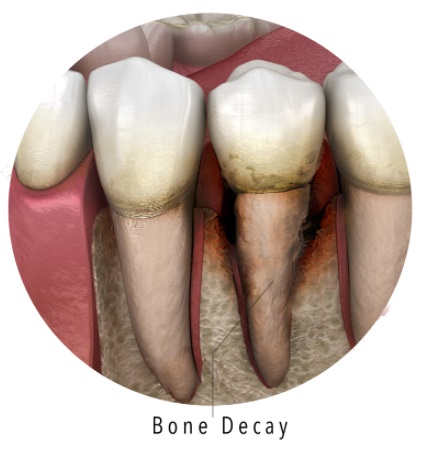
How to reverse gum disease?
While there is no curing periodontitis, there are ways to stop the progress of the disease and help mitigate the discomfort caused by having this condition.
Preventative Care is obviously the number one way to reverse periodontitis. Adopting healthy habits is the key to defeating periodontitis in the long term.
Hygiene Therapy is done by Archer Dental’s hygiene therapists who manually remove plaque from teeth in patient’s mouth. They can use deep cleaning tools to clean under the gum line.
Periodontal Laser Therapy uses a dental laser to remove inflamed gum tissue from the area around the tooth.
Traditional Periodontal Surgery is the realm of traditional periodontists and Archer Dental refers patients that need such specialists.
Is gum disease contagious?
It’s unsettling to think that kissing someone could give you periodontitis, but there is a germ of truth in the idea. Dentists will remind us that the same bacteria which causes gingivitis and gum disease is already present in everyone’s mouths on planet Earth and so there’s really no risk of spreading-it or increased risk of communicating the disease in that sense. But they might also point to studies in married couples which show how long-term exposure to gingivitis sufferers can have a debilitating effect on their partners’ oral health.
Can people with periodontal disease get dentures?
Yes, people with periodontal disease can get dentures after treatment. In fact, dentures are typically recommended for individuals who have lost teeth due to gum disease. Full or partial dentures rest on the wearer’s gums and restore the appearance and function of lost teeth. Dentures also happen to be the most economical way to replace missing teeth and can be combined with implants to preserve patients’ jaws and brilliant smiles.
Does periodontal disease kill people?
Indirectly, yes. Both gingivitis and periodontitis have been shown to raise sufferer’s risk of diabetes, heart disease, osteoporosis, pneumonia, and cancer. Early detection is your best bet!
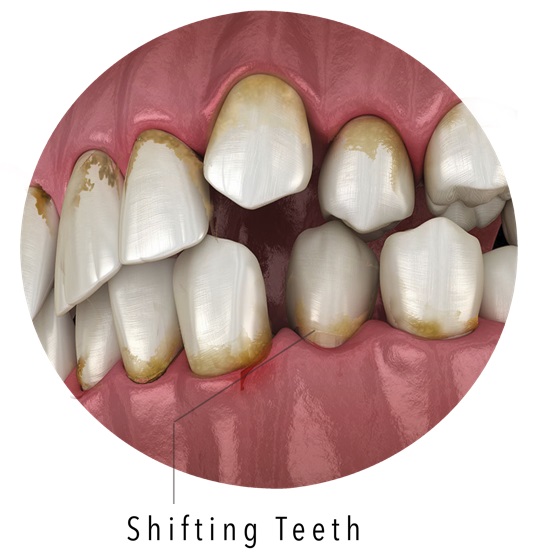
How to stop Gum Disease?
- Make sure you brush your teeth for at least two minutes, and at least twice daily
- Floss daily between all your teeth to remove plaque
- Rinse with antiseptic mouthwash. Ask your dentist what is recommended.
- Make healthy food choices. Not only is it good for your oral health, it’s good for your whole body
- Regularly schedule and attend your dental appointments with your dental team
- Quit smoking. Studies have linked cigarettes with destroyed bones that support the teeth. Smoking also weakens the immune system, increasing your chances of periodontal disease
If patients can follow these six simple steps, which require just a few minutes attention each day, periodontal disease is easily preventable.
Archer Dental offers you three convenient locations: Archer Dental Rosedale at Sherbourne and Bloor, and Archer Dental Baby Point at 387 Jane St., and now at 583 College St, Archer Dental Little Italy. All three locations are easily accessible via public transit, vehicle or foot.

